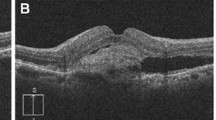Abstract
DJ is a 34-year-old man who noted flashes of light in the right eye for 2 days and then a “lacy cobweb with lots of little black specks” on the day of presentation at his ophthalmologist’s office. Examination revealed visual acuity of 20/200 with some variability as he moved his eye around. Ophthalmoscopy found a 2+ vitreous hemorrhage that obscured visualization of the peripheral inferior temporal fundus. Some vitreous membrane formation was noted, but retinal detail was hazy.
You have full access to this open access chapter, Download chapter PDF
Similar content being viewed by others
Keywords
These keywords were added by machine and not by the authors. This process is experimental and the keywords may be updated as the learning algorithm improves.
DJ is a 34-year-old man who noted flashes of light in the right eye for 2 days and then a “lacy cobweb with lots of little black specks” on the day of presentation at his ophthalmologist’s office. Examination revealed visual acuity of 20/200 with some variability as he moved his eye around. Ophthalmoscopy found a 2+ vitreous hemorrhage that obscured visualization of the peripheral inferior temporal fundus. Some vitreous membrane formation was noted, but retinal detail was hazy.
Echography was performed and demonstrated a total posterior vitreous detachment with moderate intravitreal hemorrhage. An area of vitreoretinal traction was noted at the 5:00 position anterior to the equator. There was the appearance of a flap tear but the adjacent retina was not elevated and no subretinal fluid could be detected (Fig. 1). He was carefully followed by daily echography to verify that the retina was not detaching. When the vitreous hemorrhage had cleared to allow a reasonable view of the fundus, photocoagulation around the tear was performed.
Echography can detect subretinal fluid in the presence of a retinal tear, and this provides the retinal surgeon with information to assist in optimizing treatment options from laser to a scleral sponge.
Author information
Authors and Affiliations
Rights and permissions
Copyright information
© 2014 Springer Science+Business Media New York
About this chapter
Cite this chapter
Harrie, R.P., Kendall, C.J. (2014). Case Study 86 Retinal Tear. In: Clinical Ophthalmic Echography. Springer, New York, NY. https://doi.org/10.1007/978-1-4614-7082-3_86
Download citation
DOI: https://doi.org/10.1007/978-1-4614-7082-3_86
Published:
Publisher Name: Springer, New York, NY
Print ISBN: 978-1-4614-7081-6
Online ISBN: 978-1-4614-7082-3
eBook Packages: MedicineMedicine (R0)





